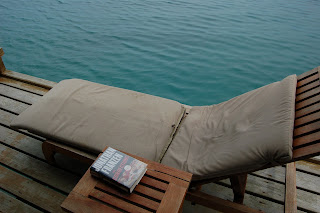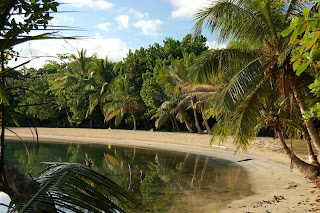
Better late than never, right? At this rate, I'll get the third and final part of this recap up by September of next year.
Aaaanyway. After our four nights at Coral Lodge, it was time to head back to the city. For the first time since the night we arrived, it rained. The trip back took us along the coast by boat for 50 minutes or so to the Portobelo area, and then we hopped in a minibus and took the long trip along the canal back to Panama City and La Estancia, the bed and breakfast that was to be our base of operations for the rest of the trip.

The day was somewhat rainy. The driver from La Estancia dropped us off at Isla Flamenco, one of the three islands connected by the Amador Causeway. From there, a bus took us to Gamboa, on the south shore of Lake Gatun, where we met our tour boat, the Pacific Queen. The tour guide spoke both English and Spanish, and kept up a running commentary throughout the trip.

Each ship that passes through the canal, be it our tiny tour boat Pacific Queen, a Panamax freighter, or a luxury yacht like the one above, has to pay a toll. The toll is determined by several factors, including what the cargo is; the largest toll ever paid was paid by a cruise ship, at over $417 000 for the full transit, as humans are considered the "most precious cargo." Most ships going through the canal, the big Panamax freighters, only pay around $100 000 per trip. This toll doesn't include incidental costs, such as the mandatory nanny tug or the mandatory canal pilot, who captains the ship for the duration of its trip through the canal. Even our little tour boat had a canal pilot.

We saw a couple of these creatures on the canal; I believe there are four in operation at all times. This barge drills holes in the bottom of the canal, which is hard-packed silt and rock. Once the holes are drilled, they're packed with explosives. The explosives are detonated and another giant machine comes in to dredge the canal bottom, to keep it deep enough for Panamax ships, and one assumes, eventually post-Panamax ships. The ship below is one of the dredgers, a little further down the canal:
Panoramic Panama is a tour agency that runs out of La Estancia, owned by the same people. So when we booked our room, we also booked two tours: a canal half-transit, and a birdwatching tour. In fact, when figuring out lodgings and so on, we arranged our trip around the canal transit, since they only happen on Saturdays, and it seemed somewhat ludicrous to go to Panama and not spend time on the Canal. Unfortunately, they only do full transits once a month, and the week we were there was not the full transit one. But that turns out to have been all right; the half-day trip was fascinating, and it left us time to visit Casco Viejo (old Panama City) in the evening and have our nicest dining experience of the trip.
But the Canal. Doing a half-transit allowed us to see some of the most interesting parts, go through a couple locks, and learn a rather insane number of statistics.

The day was somewhat rainy. The driver from La Estancia dropped us off at Isla Flamenco, one of the three islands connected by the Amador Causeway. From there, a bus took us to Gamboa, on the south shore of Lake Gatun, where we met our tour boat, the Pacific Queen. The tour guide spoke both English and Spanish, and kept up a running commentary throughout the trip.

Each ship that passes through the canal, be it our tiny tour boat Pacific Queen, a Panamax freighter, or a luxury yacht like the one above, has to pay a toll. The toll is determined by several factors, including what the cargo is; the largest toll ever paid was paid by a cruise ship, at over $417 000 for the full transit, as humans are considered the "most precious cargo." Most ships going through the canal, the big Panamax freighters, only pay around $100 000 per trip. This toll doesn't include incidental costs, such as the mandatory nanny tug or the mandatory canal pilot, who captains the ship for the duration of its trip through the canal. Even our little tour boat had a canal pilot.

We saw a couple of these creatures on the canal; I believe there are four in operation at all times. This barge drills holes in the bottom of the canal, which is hard-packed silt and rock. Once the holes are drilled, they're packed with explosives. The explosives are detonated and another giant machine comes in to dredge the canal bottom, to keep it deep enough for Panamax ships, and one assumes, eventually post-Panamax ships. The ship below is one of the dredgers, a little further down the canal:
So, all of this constructiony activity explains the muddy condition of the water, as does the fact that it's all freshwater constantly being stirred by enormous amounts of shipping traffic. It also explains why the corporation that owns the Canal charges so much for a transit; maintenance costs must be insane. Consider the amount of money just one of those drills or dredgers must cost, when something like the little locomotives that guide large ships through the locks cost over $2 million apiece.

Our little tour boat didn't need these locomotives, which are attached to ships by linesmen whose sole job it is to attach lines from big ships to the locomotives so that the ships don't bash the walls of the locks to pieces when entering, exiting, or sitting in the lock -- the tension has to be just right on each of the lines. I believe it also helps prevent the ships from running into the lock doors, though the doors we saw had dents in them. That was only the inner set, though, as all the locks have two sets. We didn't stand much of a chance of bashing the walls or the doors too badly, so the locomotives and the linesmen didn't bother with us.
The Panama Canal locks, when they were built in the early 1900s, were the first major structure to make use of the new building material concrete. Nothing on the scale of the Canal had ever been done, and engineers weren't sure how much concrete would be needed -- there's a lot of pressure on the middle wall when the lock on one side of the wall is full, and the other is empty. So they decided to play it safe, and the concrete wall separating the locks from each other is 50 feet thick. Which is massive.

Now, having spent some time in Thorold, living close enough to the Welland Canal to be able to see the lakers from the top of the hill on our street, the experience of going down the locks wasn't terribly novel for me. But the scale of these structures is something, and the amount of fresh water used every time the lock steps up or down a level is staggering. I was there, and I still couldn't really grasp the real, tangible amount. Luckily, Panama gets enough rainfall that they need to actually let it drain elsewhere, rather than jealously guard it to make sure that the Canal can keep running -- but they track their water usage very carefully, and we were lucky to not have to wait for a bunch of other smaller ships to join us in the locks.
The little boat behind us was the Isla Morada, the oldest continuously-running ship on the Canal. Apparently possibly owned by Al Capone at one point, currently used for ferrying tourists like us up and down the Panama Canal. It was a rather pretty little wooden boat. Behind the Isla Morada you can just see the bridge of a Panamax ship going the other direction, up a level as we were going down.
The shipyard in Panama City at the mouth of the Canal is huge. One thing I thought was pretty cool was that when the Canal was built, each lock could hold six of the largest ocean-faring ships at a time. Currently, about 20% of the world's shipping fleet is too large to fit in these locks. They're building a whole new set parallel to the current system.
Shipping companies can get around the Canal by offloading the cargo that needs to go through the Canal at either mouth, transferring it to the Panama Canal Company's dedicated railway, and picking it up with another ship at the other end. The equipment at this transfer point is pretty impressive and astonishing in its scale, too. There is so. much. stuff. in those containers. From all over the world.
Upon ending our transit, our canal pilot left via launch pulling itself alongside our tour boat (the leap from one to the other was a crowd-pleaser; everyone applauded), and we made our way back to harbour, then back to La Estancia.
From there we took a cab to the old city, of which we unfortunately have no photos; we didn't feel like taking the camera and being singled out as tourists, though I'm sure my perpetual trying-to-understand-Spanish-without-its-"s"s squint was a bit of a giveaway. We ended up at a lovely little restaurant called Ego on one of the squares, where we ate waaaay too much food and drank at least a little too much sangria, and felt very provincial and sophisticated sitting outside in the warm Panama evening. It was lovely, and I wish I'd gotten up the energy and courage to do it again, though we only had one more night left.
If you're curious about the canal, the Canal Authority's website is pretty good, and there are even real-time webcams trained on the locks. We waved at them when we were going through the Miraflores locks.
Next: La Estancia, birdwatching, and a final walk. Coming sometime in the new year, I swear.











